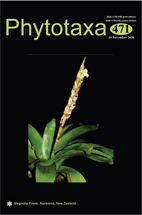Abstract
The genus Tripidium Scholz in Valdés & Scholz (2006: 664) (Poaceae: Andropogoneae) currently includes six species, distributed in Asia, southern Europe, and northern Africa, with the greatest diversity in India (Welker et al. 2019). The species of Tripidium have traditionally been treated as part of the “Saccharum complex”, formed by sugarcane [S. officinarum Linnaeus (1753a: 54)] and relatives, being included either in the genus Saccharum Linnaeus (1753a: 54) (e.g., Clayton & Renvoize 1986, Shouliang & Phillips 2006) or in Erianthus Michaux (1803: 54) (e.g., Mukherjee 1958, Besse et al. 1997). However, recent nuclear and plastome phylogenies (Welker et al. 2015, 2019, Lloyd Evans et al. 2019, Welker et al. in press) have unequivocally demonstrated that Tripidium belongs to a different lineage from sugarcane and relatives and thus should be accepted as a genus distinct from Saccharum or Erianthus. According to the plastome phylogeny of Welker et al. (in press), Tripidium is sister to the newly circumscribed subtribe Rottboelliinae, which comprises the genera Rottboellia Naezén (1779: 23) s.str. and Coix Linnaeus (1753b: 972).
References
<a href="http://dx.doi.org/10.1023/A:1002940701171">http://dx.doi.org/10.1023/A:1002940701171</a>
Clayton, W.D. & Renvoize, S.A. (1986) Genera graminum: grasses of the world. Her Majesty’s Stationery Office, London, 389 pp.
Grassl, C.O. (1972) Taxonomy of Saccharum relatives: Sclerostachya, Narenga, and Erianthus. Proceedings of the 14th Congress of the International Society of Sugar Cane Technologists (ISSCT): 240–248.
Grisebach, A.H.R. (1868) Ueber die Gramineen Hochasiens. Nachrichten von der Königlichen Gesellschaft der Wissenschaften und der Georg-Augusts-Universität zu Göttingen 3: 61–93.
Host, N.T. (1802) Icones et descriptiones graminum austriacorum, vol. 2. A. Schmidt, Vienna, 72 pp.
<a href="https://doi.org/10.5962/bhl.title.507">https://doi.org/10.5962/bhl.title.507</a>
Linnaeus, C. (1753a) Species plantarum, vol. 1. Impensis Laurentii Salvii, Holmiae, 560 pp.
<a href="https://doi.org/10.5962/bhl.title.669">https://doi.org/10.5962/bhl.title.669</a>
Linnaeus, C. (1753b) Species plantarum, vol. 2. Impensis Laurentii Salvii, Holmiae, 1200 pp.
<a href="https://doi.org/10.5962/bhl.title.669">https://doi.org/10.5962/bhl.title.669</a>
Linnaeus, C. (1763) Species plantarum, ed. 2, vol. 2. Impensis Direct. Laurentii Salvii, Holmiae, 1684 pp.
<a href="https://doi.org/10.5962/bhl.title.11179">https://doi.org/10.5962/bhl.title.11179</a>
Lloyd Evans, D., Joshi, S.V. & Wang, J. (2019) Whole chloroplast genome and gene locus phylogenies reveal the taxonomic placement and relationship of Tripidium (Panicoideae: Andropogoneae) to sugarcane. BMC Evolutionary Biology 19: 33.
<a href="https://doi.org/10.1186/s12862-019-1356-9">https://doi.org/10.1186/s12862-019-1356-9</a>
Michaux, A. (1803) Flora boreali-americana, vol. 1. Levrault, Paris & Strasbourg, 330 pp.
<a href="https://doi.org/10.5962/bhl.title.330">https://doi.org/10.5962/bhl.title.330</a>
Mukherjee, S.K. (1958) Revision of the genus Erianthus Michx. (Gramineae). Lloydia 21: 157–188.
Naezén, D.E. (1779) Dissertatio botanica, illustrans Nova graminum genera. Apud Johan Edman, Upsaliae, 37 pp.
Ohwi, J. (1938) Symbolae ad floram Asiae Orientalis 16. Acta Phytotaxonomica et Geobotanica 7: 29–41.
<a href="https://doi.org/10.18942/bunruichiri.KJ00002594459">https://doi.org/10.18942/bunruichiri.KJ00002594459</a>
Retzius, A.J. (1786) Observationes botanicae, vol. 4. Siegfried Lebrecht Crusium, Leipzig, 30 pp.
<a href="https://doi.org/10.5962/bhl.title.11760">https://doi.org/10.5962/bhl.title.11760</a>
Retzius, A.J. (1789) Observationes botanicae, vol. 5. Siegfried Lebrecht Crusium, Leipzig, 32 pp.
<a href="https://doi.org/10.5962/bhl.title.11760">https://doi.org/10.5962/bhl.title.11760</a>
Roxburgh, W. (1820) Flora indica; or descriptions of Indian plants, vol. 1. Mission Press, Serampore, 493 pp.
<a href="https://doi.org/10.5962/bhl.title.589">https://doi.org/10.5962/bhl.title.589</a>
Shouliang, C. & Phillips, S.M. (2006) Saccharum Linnaeus. In: Zhengyi, W., Raven, P.H. & Deyuan, H. (Eds.) Flora of China, vol. 22, Poaceae. Science Press, Beijing; Missouri Botanical Garden, St. Louis, pp. 576–581.
Steudel, E.G. (1854) Synopsis plantarum glumacearum, vol. 1. J.B. Metzler, Stuttgart, 475 pp.
<a href="https://doi.org/10.5962/bhl.title.471">https://doi.org/10.5962/bhl.title.471</a>
Turland, N.J., Wiersema, J.H., Barrie, F.R., Greuter, W., Hawksworth, D.L., Herendeen, P.S., Knapp, S., Kusber, W.-H., Li, D.-Z., Marhold, K., May, T.W., McNeill, J., Monro, A.M., Prado, J., Price, M.J. & Smith, G.F. (Eds.) (2018) International Code of Nomenclature for algae, fungi, and plants (Shenzhen Code) adopted by the Nineteenth International Botanical Congress Shenzhen, China, July 2017. Regnum Vegetabile 159. Koeltz Botanical Books, Glashütten.
<a href="https://doi.org/10.12705/Code.2018">https://doi.org/10.12705/Code.2018</a>
Valdés, B. & Scholz, H. (2006) The Euro+Med treatment of Gramineae – a generic synopsis and some new names. Willdenowia 36: 657–669.
<a href="http://dx.doi.org/10.3372/wi.36.36202">http://dx.doi.org/10.3372/wi.36.36202</a>
Welker, C.A.D., Souza-Chies, T.T., Longhi-Wagner, H.M., Peichoto, M.C., McKain, M.R. & Kellogg, E.A. (2015) Phylogenetic analysis of Saccharum s.l. (Poaceae; Andropogoneae), with emphasis on the circumscription of the South American species. American Journal of Botany 102: 248–263.
<a href="https://doi.org/10.3732/ajb.1400397">https://doi.org/10.3732/ajb.1400397</a>
Welker, C.A.D., McKain, M.R., Vorontsova, M.S., Peichoto, M.C. & Kellogg, E.A. (2019) Plastome phylogenomics of sugarcane and relatives confirms the segregation of the genus Tripidium (Poaceae: Andropogoneae). Taxon 68: 246–267.
<a href="https://doi.org/10.1002/tax.12030">https://doi.org/10.1002/tax.12030</a>
Welker, C.A.D., McKain, M.R., Estep, M.C., Pasquet, R.S., Chipabika, G., Pallangyo, B. & Kellogg, E.A. (In press) Phylogenomics enables biogeographic analysis and a new subtribal classification of Andropogoneae (Poaceae–Panicoideae). Journal of Systematics and Evolution.
<a href="https://doi.org/10.1111/jse.12691">https://doi.org/10.1111/jse.12691</a>

